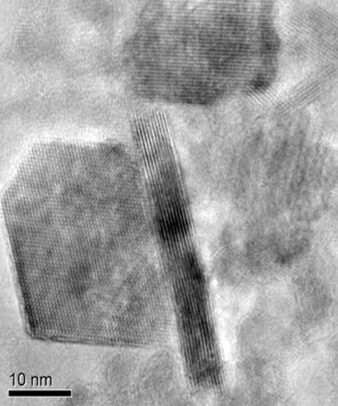博文
石墨烯涂层可以帮助防止锂电池起火
|||
石墨烯涂层可以帮助防止锂电池起火
诸平
据伊利诺斯大学芝加哥分校(University of Illinois at Chicago,UIC)2019年4月9日提供的消息,該大學的研究人員使用氧化钴锂颗粒包覆石墨烯(見圖1所示),將其用於电动汽车的鋰電池。使其一次充电可以行驶几百英里。它们储存能量的能力是众所周知的,但它们偶尔着火的倾向也是众所周知的——电池研究人员称之为“热失控”。当电池过热或快速循环时,这些火灾发生的最频繁。随着每年有越来越多的电动汽车上路,电池技术需要适应以减少这些危险和灾难性火灾的可能性。

Fig. 1 Lithium cobalt oxide particles coated in graphene. Credit: Reza Shahbazian-Yassar.
伊利诺斯大学芝加哥分校工程学院的研究人员报告说,石墨烯作爲21世纪的神奇材料,它可能会从锂电池火灾中提取氧气。他们的研究结果于2019年4月5日发表在《高级功能材料》(Advanced Functional Materials)杂志上——Soroosh Sharifi‐Asl, Fernando A. Soto, Tara Foroozan, Mohammad Asadi, Yifei Yuan, Ramasubramonian Deivanayagam, Ramin Rojaee, Boao Song, Xuanxuan Bi, Khalil Amine, Jun Lu, Amin Salehi‐khojin, Perla B. Balbuena, Reza Shahbazian‐Yassar. Anti‐Oxygen Leaking LiCoO2. Advanced Functional Materials, First published: 05 April 2019. https://doi.org/10.1002/adfm.201901110
锂电池着火的原因包括快速循环或充放电,以及电池内的高温。这些条件会导致电池内部的阴极——在大多数锂电池的情况下是含有锂的氧化物,通常是锂钴氧化物——分解并释放氧气。如果氧气与电解质在足够高的热量下分解释放出的其他易燃产品结合,就会发生自燃。 此論文的通訊作者之一,伊利诺斯大学芝加哥分校机械和工业工程学院Reza Shahbazian-Yassar副教授說:“我们认为,如果有一种方法,以防止阴极產生的氧与鋰電池中的其他易燃产品混合,我们就可以减少火灾发生的可能性。“ 结果表明,一种Reza Shahbazian‐Yassar熟悉的材料为这个问题提供了一个完美的解决方案,这种材料就是石墨烯,它是一种具有独特性质的超薄碳原子层。Reza Shahbazian‐Yassar和他的同事以前曾使用石墨烯帮助调节锂金属电池电极上的锂积聚。 Reza Shahbazian‐Yassar和他的同事知道石墨烯片对氧原子是不渗透的。石墨烯还具有强度高、柔韧性好、可导电等优点。Reza Shahbazian‐Yassar和Soroosh Sharifi‐Asl认为,如果将锂电池的钴酸锂阴极的非常小的颗粒包裹在石墨烯中,就可能阻止氧气逸出。Soroosh Sharifi‐Asl是UIC机械和工业工程专业的研究生,也是这篇论文的第一作者。 首先,研究人员用化学方法改变石墨烯,使其具有导电性。接下来,他们将锂钴氧化物阴极电极的微小颗粒包裹在导电石墨烯中。当他们用电子显微镜观察石墨烯包裹的锂钴氧化物颗粒时,他们发现,与未包裹的颗粒相比,高温下氧的释放明显减少。 接下来,他们用一种粘合材料将包裹的粒子與石墨烯固定在一起,形成一个可用的阴极,并将其并入金属锂电池中。当他们测量电池循环过程中释放的氧气时,他们发现即使在非常高的电压下也几乎没有氧气从阴极中逸出。即使在200次循环之后,锂金属电池仍然表现良好。 Soroosh Sharifi‐Asl说:“与传统的锂金属电池相比,包裹式阴极电池在快速循环后仅损失了约14%的容量,而在相同条件下,传统锂金属电池的性能下降了约45%。”“石墨烯是阻止氧气进入电解质的理想材料。”“它是不透氧的,导电的,柔軟灵活的,在鋰電池内具有足够强大的承受能力。它只有几纳米厚,所以不会對鋰電池添加太多的额外的质量。我们的研究表明,它在阴极中的使用可以可靠地减少氧气的释放,这可能是这些电池起火的风险可以显著降低的一种方式。从我们使用的手机到我们的電動汽车,都是鋰电池为其提供了动力。”更多信息請注意瀏覽原文或者相關報道。
Abstract
LiCoO2 is a prime example of widely used cathodes that suffer from the structural/thermal instability issues that lead to the release of their lattice oxygen under nonequilibrium conditions and safety concerns in Li‐ion batteries. Here, it is shown that an atomically thin layer of reduced graphene oxide can suppress oxygen release from LixCoO2 particles and improve their structural stability. Electrochemical cycling, differential electrochemical mass spectroscopy, differential scanning calorimetry, and in situ heating transmission electron microscopy are performed to characterize the effectiveness of the graphene‐coating on the abusive tolerance of LixCoO2. Electrochemical cycling mass spectroscopy results suggest that oxygen release is hindered at high cutoff voltage cycling when the cathode is coated with reduced graphene oxide. Thermal analysis, in situ heating transmission electron microscopy, and electron energy loss spectroscopy results show that the reduction of Co species from the graphene‐coated samples is delayed when compared with bare cathodes. Finally, density functional theory and ab initio molecular dynamics calculations show that the rGO layers could suppress O2 formation more effectively due to the strong COcathode bond formation at the interface of rGO/LCO where low coordination oxygens exist. This investigation uncovers a reliable approach for hindering the oxygen release reaction and improving the thermal stability of battery cathodes.
https://blog.sciencenet.cn/blog-212210-1172766.html
上一篇:监视细胞的饮食习惯可能有助于癌症的诊断
下一篇:研究表明,元素可以同时是固体和液体